Latest Posts by oliviasstudyblrshit - Page 9
Hey, can you suggest some books and poems dealing with mental illness, something along the lines of 4.48 psychosis by Sarah Kane?? ps. you have an impeccable literary taste 🖤
i’m sure if you’ve read 4.48 psychosis then you’re aware of how full on it is so trigger warnings apply for all of these, read with caution. i’m sure there’s many more novels out there but these were the ones that came to mind first <3
the centre cannot hold, elyn r. saks
madness, marya hornbacher
collected poems of sylvia plath (& the bell jar)
girl interrupted, susanna kaysen
mrs. dalloway, virginia woolf
no exit, jean paul sartre
waiting, marya hornbacher
an unquiet mind, kay redfield jamison
blue nights, joan didion
hunger, roxane gay
the particular sadness of lemon cake, aimee bender
prozac nation, elizabeth wurtzel
Lovely things to include more in your life:
walking in the rain
waking up feeling refreshed
turning off your phone
hugging your friends
complimenting people
museum visits
taking photos of yourself and people u love
planting flowers and fruit trees
ice-cream in summer
songs to dance to
learning things because it interests you
walks in the middle of nature
cute pens and notebooks
cooking your own meals
potted plants in your room
sleeping on fresh linen
eating fruits
writing poems or diary entries
riding a bike
dancing to songs you like
scented candles
make bucket lists and goals
watching classic films
swimming in the ocean
enjoying solitude
getting lost in a book
singing without worrying how you sound
smiling
jewellery that has a special meaning to you
warm knitted sweaters
starting conversations
visits to the beach or park during sunset
making your bed
planning your day
freshly baked bread
drinking enough water
having a tidy room
decorations, like fairy lights and posters
words and books that inspire you
doodling and writing in a journal
exploring your city
being the friend you needed when you were younger
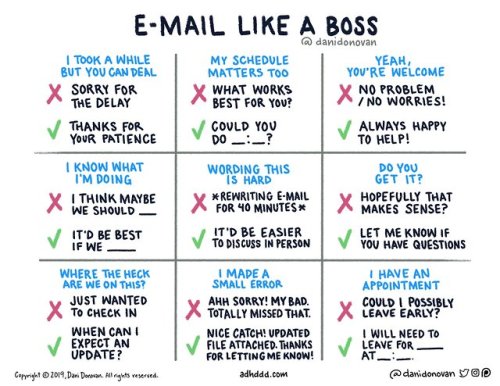
I’ve been working on being more conscious of how I write emails, and made this handy printable guide! I have a bad habit of overusing exclamation points, emojis, and qualifiers like “just” and “possibly” to sound extra-friendly and non-threatening in emails. (“Just wondering / just confirming / just checking / just making sure / just wanted to let you know”) You are allowed to take up space. Your voice deserves to be heard. Your opinions matter. You don’t need to apologize for existing or asking for what you need. You are not “bossy” or “bitchy” for not sounding like a pep-machine 24/7. If you act like a doormat, you better develop a taste for shoe leather. You have power too. Don’t be afraid to stand up for yourself— no one else is gonna do it for you.

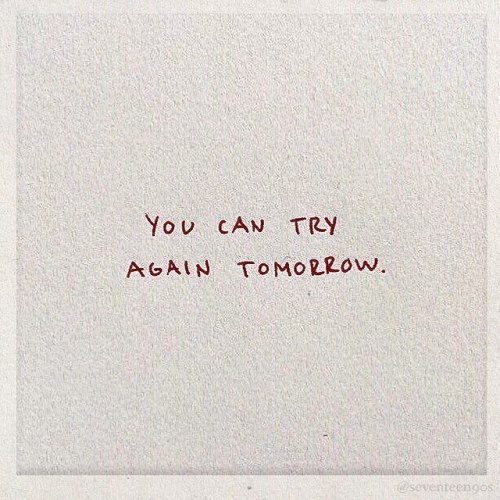
✧・゚: ✧ tag yourself: classes at hogwarts ✧:・゚✧
potions: rainy days, ambition, old textbooks, staying up all night, dark circles, high ponytails, sharp smiles, red lipstick, denim jackets
divination: tarot cards, long dresses, crystals, birth charts, black lipstick, dancing under the moon, lighting candles, space buns, constellations
history of magic: open books, messy buns, castles, filled notebooks, handwritten poems, architecture, studying in the library, cups of tea
charms: soft laughter, braids, mom jeans, fairy lights, fresh sheets, layered necklaces, sparkly lipgloss, watercolour paintings, quiet voices
care of magical creatures: holding hands, sunflowers, cinnamon, baked cookies, freckles, golden highlighter, movie nights, campfires, hot chocolate
defense against the dark arts: city lights, thunderstorms, winged eyeliner, ripped jeans, concerts, tattoos, silver jewellery, impulsiveness, dark eyeshadow
ancient runes: learning languages, iced coffee, travelling, polaroids, scrap books, fading tanlines, walking along the beach, to do lists, postcard collections
herbology: pine trees, dried herbs, taking a walk in the woods, round glasses, tangled hair, flower crowns, shy laughs, going out to protest, cozy sweaters



officially started my bullet journal, I’ll mainly use it as a reading and study tracker and for daily to do lists! here you can see my Gilmore Girls reading list featuring all the books mentioned in the show (aka my all time favorite TV show) ☕
instagram : thomreads
What did you learn about people? How might a person who is not studying develop their bullshit-ometer?
“What did you learn about people” is much too broad to answer given how much is covered in a three year bachelors degree. Everything from theories of the self, errors biases and heuristics, attitudes and emotions, theories behind behaviours, social influence, group affiliation, psychological development from childhood to adulthood and its effect, models of personality and individual differences, memory, how we learn, the psychology of choice and decisions, and the genetic/biological/social/environmental factors of all of the above and what happens when it goes wrong and becomes pathology.
In terms of developing a bullshit-ometer, or improving your judgement and understanding of evidence, the key is practice. For a module in my first year we were given a paper every week and a prompt sheet to fill in that effectively helped you tear the paper apart. Prompts included everything from the method and sample size, to the statistical tests used, whether they were used appropriately, and whether all of the assumptions of each test were met, etc. It would take me upwards of two hours to get through a ten page paper, and even then I’d miss things. Three years on, I can skim a paper or article or hear a person’s argument, spot any major red flags, and tear it apart under exam conditions in thirty minutes. It takes a lot of time and work to be able to do it quickly. Having it embedded as a philosophy into everything you’re learning helps as you start doing it unconsciously eventually.
Resources:
Bad Science by Ben Goldacre. To me, an absolutely essential read.
The Art of Statistics by David Spiegelhalter. Spiegelhalter is a statistical genius, and he’s now spending his time trying to change the way statistics is taught, moving it away from learning loads of formulas and then trying to figure out how they relate to evidence, towards the PPDAC (problem, plan, data, analysis, conclusion) model. To understand evidence and pick up the misuse of statistics (aka bullshit) you need at least a basic understand of stats. This book does it perfectly, in plain English, with interesting examples. I wish it had been published when I first started my degree.
I Think You’ll Find It’s A Bit More Complicated Than That by Ben Goldacre. This is a collection of most of Ben Goldacre’s columns which used to appear in The Guardian, in which he takes a claim in the media or a new study and tears it apart. It’s an interesting read, might change your perception on a few things, and is him tackling bullshit in practice.
Reckoning With Risk by Gerd Gigerenzer. There are lots of complex statistics in this (which he signposts and you can just pass over), but understanding how statistics of risk work, and what they mean, will completely change how you read and assess a lot of claims made in the news.
The Students 4 Best Evidence blog. It mainly covers evidence based medicine, but the key concepts transfer to all research and claims outside of medicine. Anything under the bias, critical thinking, intro to evidence-based practice, and statistics topics is relevant. Particularly anything tagged ‘tutorials and fundamentals’. Their Key Concepts Archive is a good place to start.
The Testing Treatments website. Again, covers medicine, but most of the points generalise out. Under each concept, say ‘association is not causation’, there is a ‘find learning resources’ link that will find papers, online courses/modules, and books about that concept.
Cochrane Training. Cochrane are the gods of the systematic review. All their online learning modules surrounding assessing evidence are here.
Think Again: How to Reason and Argue, either the book, or the online course. The perfect crash course in reasoning, arguing, avoiding fallacies, picking apart other people’s arguments, and finding bullshit.
The Clearer Thinking website has a range of tools/mini modules. Relevant ones here:
How well can you tell reality from B.S.?
Interpreting evidence
Belief challenger, making your views more accurate
Guess which experiments replicate
More books.
A Field Guide to Lies and Statistics: A Neuroscientist on How to Make Sense of a Complex World by Daniel Levitin
How To Lie With Statistics by Darrell Huff


may 21, 2019 / some messy class notes + doodles for you guys. just wanted to show how my in class notebook looks like

15/100 DAYS OF PRODUCTIVITY
• attended volleyball practice (it went well and even found an old friend of mine who has basketball classes there)
• took some time to bujo/journal
• worked on some biology notes (even though the test was last week!)
• did my biology homework
• did my english (C2) homework
Beginner Japanese Resources

I’ve seen quite a lot of these going around, and have definitely taken quite a few pages out of their books, but I thought I had some bookmarks I’d like everyone to know more about, even if they already did. ^^ If you think something is wrong, or know something is wrong, then please tell me!
g r a m m a r
Tae Kim’s Guide to Japanese Grammar (easy acquaintance with grammar, but not much in-depth)
IMABI (best free grammar resource but too much information for beginners, or so it’s said. still very helpful.)
Tim’s Takamatsu/ Tim Sensei’s Corner (also good. i heard of someone who printed out the older website and got fluent in Japanese with this, so it’s probably worth checking out)
Dictionaries of Japanese Grammar (hands down the best grammar resource, bit pricey or you could just download these PDFs).
Bunpro (good for interactive grammar studies, free until may 10 and there’s a one month free trial for subscription after that)
g r a m m a r / b l o g s
Japanese Ammo (native speaker and tutor’s blog, she also has a Youtube channel here)
Maggie-Sensei (grammar articles are a bit mismatched but good for little references)
Tofugu (probably the best culture and resources blog I’ve come across. a must.)
Romy-sensei (Japanese teacher, blog is VERY helpful)
DJT Guide (for a beginner outlook on how to start and where, named because of the daily japanese thread that I don’t have too much information on but it’s a daily thread where people learning japanese shared resources/ progress/ motivational whatevers)
i n t e r a c t i v e l e a r n i n g
Delvin Language (shows clips and asks you to identify what’s spoken. Very good for listening and you can slow them down, though use that sparingly. kinda spammy tho.)
Japanese Class (found this a few years ago, but it’s a gamified site that helps you learn vocabulary with regular exposure. recommended.)
Japanese in Anime and Manga (for fellow otakus. a bit hard for me to navigate, but it’s along a similar vein as the above site. offered in spanish, chinese, korean and french, besides english.)
Erin’s Challenge (recommended for upper beginners, or lower intermediates, but there’s a lot to do now as well! very good for listening and reading- with transcripts and subtitles- in the form of a school life role-play. offered in quite a few other languages.)
Duolingo (not a lot of information, nor is it very in-depth. good for dabbling in, maybe. try the website, not the app, if you really want to use it.)
LingoDeer (BEST app for learning the language. You could do a lot on it alone, and it can probably take you up to a little above N5, but don’t keep using it standalone for long! also offers chinese, korean and now vietnamese!)
t e x t b o o k s
TextFugu (tofugu’s online textbook, made specifically for self-study, though it works good in conjunction with classes and tuition)
Genki (widely used, most recommended by people)
Minna no Nihongo (also very popular. some consider it better than genki.)
Japanese for Busy People (especially if you’re a little short on time)
Japanese for Everyone (generally good reviews, with a lot of vocabulary - an estimated 2500 maybe? convert djvu to pdf to use.)
k a n j i (course books)
Kodansha Kanji Learner’s Course aka KKLC (a kanji learning course with vocabulary in it.)
Remembering the Kanji (aka the acclaimed ‘Japanese learner’s beginning holy grail’. but it totally depends upon what you’d prefer tbh. can make you recognise kanji and what they could stand for, but that’s about it.)
Kanji Damage (aka remember 1700 Kanji with offensive yo mama jokes. ridiculous? hilariously, it does work for some.)
WaniKani (people swear by this. you can try out the first three levels to see the magic, even if you don’t think it’s your style.)
l i s t e n i n g
mykikitori (for Genki 1 apparently)
Japanese Pod 101 (a good online course in itself, but the podcasts are the most helpful of the lot. @lovelybluepanda has made them available here.)
o t h e r s
DJT Resources (sub-link of DJT Guide but probably has all the Japanese resources you could ever want!)
Nihongo e Na (more resources, probably worth checking out)
Nihongo Resources (along a similar vein with the purpose in its name)
Jakka (the site is entirely in Japanese, but it has kanji for grade school, broken up appropriately)
Happy Lilac (kind of the same as above with kanji stroke order practice material, meant for Japanese children)
This may be repeated, because similar, if not the exact same, resources in DJT are categorised neatly here. @lovelybluepanda again.
check more masterposts, some of which have been compiled here by @languagesandshootingstars
日本語の森 (Nihongo no Mori) (Good Youtube videos for beginners and advanced learners alike! They even have their lessons separated by JLPT levels!)
While that’s it for all the Japanese resources I feel do not go around a lot now, I did compile some points Japanese beginners might be doubtful in and what I had found from my own research.
Genki or Minna no Nihongo?
Minna no Nihongo has more vocabulary (2100-2200 for 初級 levels i.e. the beginner books) while Genki boasts a little lesser (1700 for genki 1+2). Minna no Nihongo has allegedly more grammar coverage ( 〜ように、〜ために- used in native speech). However, the book is entirely in Japanese (there is a separate book for English explanations) and there is a separate book for Kanji too. The Answer Key is at the back of the book, unlike Genki which has a separate Answer Key.
Genki is said to be more beginner-friendly than Minna no Nihongo, but if you put your mind to it, you can do either tbh. Just choose any book and stick with it!
** If you’re planning to study in Japan anytime, remember that Japanese teachers usually use Minna no Nihongo. But better do your research as well.
Kanji?
Everyone can put in all the work they like in Kanji, but at the end of the day, Kanji is not the only thing about Japanese. You can totally use Anki or Quizlet or Memrise to drill it in, maybe even make your own flashcards and put in extra work! But to really get fluent in the language, talking to native speakers (helpful guide by @jibunstudies) is very important. Even if you don’t fully understand what they’re saying, you acquire more vocabulary and will get the nuance of basic sentences! And you get friends too, if you’re lucky!
Just for reference and no pressure, here’s the general requirement to pass JLPT levels, if you’re ever planning to take them!
Level Kanji Vocabulary Listening Hours of Study N5 ~100 ~800 Beginner 150 (estimated) N4 ~300 ~1,500 Basic 300 (estimated) N3 ~650 ~3,750 Lower Intermediate 450 (estimated) N2 ~1000 ~6,000 Intermediate 600 (estimated) N1 ~2000 ~10,000 Advanced 900 (estimated)
(… yeah, that looks way better on a computer ok.) Remember, estimated doesn’t mean it will take you that much time exactly. Everyone learns differently! And ‘talent’ can be overcome by enough hard work so ファイト!
頑張れ !







free printable pomodoro tracker!
download it as a png or as a pdf on my google drive!
available in monochrome, red, and green. just ask for more colors or adjustments!
let me know how it goes. tag me in your post with an @ or using the tag studywithvictory!
credit to @phoebe-does for the quote in the example! <3
don’t know what a pomodoro is? more info under the cut:
Keep reading

How to start a studyblr blog
One of the most common questions I am asked is how to start and run a studyblr. Some people consider being a studyblr means having a selection of certain pens or highlighters but that isn’t the case. Having a studyblr is about being part of a community that promotes self-improvement, positive study habits and tips to help yourself and others reach their full potential. Below are a few steps I recommend when starting a studyblr:
1. Decide whether you’re going to start a new blog or a secondary blog. Most studyblrs, myself included, run main blogs and then a studyblr as a side blog. If you’re wanting to have a completely new account, follow only studybrs, message (via asks) with a link to your studyblr then it is best to create a new account. If you’re happy to continue on one account, then creating a side blog is a good option. However, when you use a secondary blog for your studyblr, it will follow as your main account. I prefer having my studyblr as a secondary blog since you can stay logged into one account (so much easier on mobile!). Plus if you wanted to run a collaboration blog, you can add other members. Here is so more detailed information about the differences.
2. Pick a username/URL. You can be super creative like me and just use your name! Otherwise, you can name your studyblr anything you want. Whilst most people have a study related username, that isn’t totally necessary. Find something you like and use it! You do have the option to change it later on it you’re unhappy or think of something better.
3. Choose a theme. My best advice for a theme is pick something that is easy to navigate and nice to look at! Editing HTML can be quite difficult for first time Tumblr users, however many themes make adjusting the appearance of your theme really simple by using the tools on the customise page. Some popular theme makers include:
@pohroro
@modernisethemes
@cyantists
@magnusthemes
@sorrism
@acuite
@themesbyflorels
@roxiestheme
@felinum
@bychloethemes
@wonderfullythemes
Once you’ve picked a theme, follow the instructions the theme maker has left in the caption of the post. When you’re using a theme, remember to leave credit visible to the owner. By removing credit you’re breaking the conditions set by the creator.
4. Make an icon. This is relatively optional. Most studyblrs just use a random picture for their icon however others create personalised ones just for their blog. You can create your own icon using applications like Adobe Photoshop, Adobe Illustrator, Canva or Word/Pages. Canva is probably the easiest way to make your own, plus it is free! If you’re looking for something a little fancier, you can commission @annistudio to make one! Depending on the level of complexity, she charges between $3-9. She created my icon and it is so amazing!
5. Write up an introductory post. Once your blog is up and running, you should create a post to introduce yourself. Tell us a little bit about yourself, where you’re from, what you’re studying, your hobbies, etc. It is always nice to tag some of your favourite studyblrs! If someone has mentioned me or tagged #emmastudies in their post, I might see it and reblog it. Most blogs do the same! Making these posts will hopefully get you some new followers!
6. Post your own content. A great way to promote your blog is to upload your own posts. This can be anything, either pictures of your notes, advice posts, or infographics! Remember to update the content source and click-through links when uploading your posts. A little guide to taking photos can be found here. My editing process can also be found here. If you upload your own tips posts, feel free to submit them to @studyblrmasterposts.
7. Use popular hashtags. Before publishing your post remember to add hashtags. The most popular ones include #studyblr, #studyspo, #study. I track the tag #emmastudies so include that in your tags and I’ll see it! Most blogs also track their usernames so tag some of your favourites.
8. Join studyblr networks. You’ll often see these floating around Tumblr so if you see one, join it! There are ones dedicated to people graduating in a specific year, others for specific majors, or people who share a common trait/hobby! Alternatively, you can be added to my studyblr directory. It is a collection bloggers which can be filtered by categories such as education level, country, and exam system. You can apply here.
9. Use the queue option. By using the queue option, you don’t have to come on Tumblr every day to stay active. Set up a queue, select the number of posts and when you’d like them to be published and you’re ready to go. This option is great if you’re having a bit of an off-week and don’t fancy coming online or aren’t able to access the Internet!
10. Use other social media platforms. Whilst studyblr originated on Tumblr, we have since diversified across numerous different social networks. I’d totally recommend having a studygram! Mine is @emmastudiess if you wanted to check it out! Other accounts have YouTube (emma studies), Snapchat (@emmastudies), Spotify, Twitter, etc. Remember to provide links to your each account!
11. Be nice, friendly and polite. I think this is the golden rule for any blogger. Treat everyone with respect. Be kind when answering questions. Be grateful for your followers. Please, please, please don’t send anonymous hate! If you receive it, remember to delete and block that person. The studyblr community is one of the nicest I’ve come across and we want to keep it that way.
12. Don’t be afraid to message other blogs and start a friendship! Interact with other accounts by sending them an ask or a direct message. I cannot begin to tell you how many wonderful people I’ve connected with from the studyblr community. I’d say the majority of studyblrs love receiving messages and would be happy to strike up a friendship with you!
I hope this can inspire you to start a studyblr or helps you set one up! Remember you can tag me in your introductory posts or uploaded pictures. Also, my ask and direct messages are always open if you want to chat xx
Heyy guys! I found this really cool youtuber who does japanese language videos. They are super helpful when it comes to grammar, kana, and kanji. His channel is “gaijinquest”
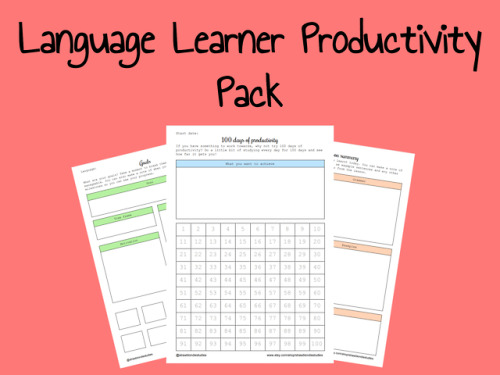
Hello hello language learning friends, I’ve added a pack of 8 productivity pages so you can organise your studies and reach your language learning goals! ✨
Includes goal planner, 100 days of productivity, study checklist, lesson summaries and more! It’s also available in 6 colours, all included in the download!! Head over to my shop to see the full list of pages included and colours available! ✨
50 Things that Top Students Do
Listen to everything they’re taught, not just hearing
Take notes
Listen to opinions they don’t like
Be open to having their minds changed
Don’t listen to music with words when studying
Practise
Commit
Keep a regimen of self-discipline even in the face of a lack of motivation
Take breaks
Sleep regularly and more than expected
Work very hard during the day
Exercise
Plan in advance
Get small tasks done when there isn’t time to do bigger ones
Engage
Take failures as a learning curve
Think positively
Do their best work at the start of the year so they get more slack later
Talk to those who teach them
Debate
Do a little every day instead of all at once
Ask for help
Help others
Drink water
Work hard but work smart
Know what study setup is their most productive
Hold themselves accountable
Figure out which work is a priority
Don’t waste time re-reading as a form of studying
Find out things they don’t understand
Test themselves frequently
Work backwards through things to understand why something works
Learn more than they need
Have more interests and hobbies than just academics
Find out the most important concepts in a course
Learn the most important 20% of the course to get 80% of the grade
Don’t complain
Tailor their courses to focus on what interests them the most
Play hard after working hard
Read in advance
Know how to say no but don’t say no unless they have to
Take every opportunity they can
Eat well
Defend their personal beliefs
Don’t use other people’s successes/failures as an excuse for anything they do
Don’t let studying become the main part of their life
Understand that everything is temporary
Set goals, short- and long-term
Put their phones away/on silent when studying
Don’t expect any results immediately
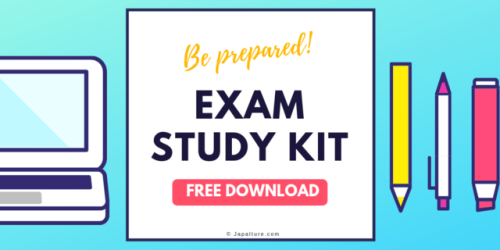
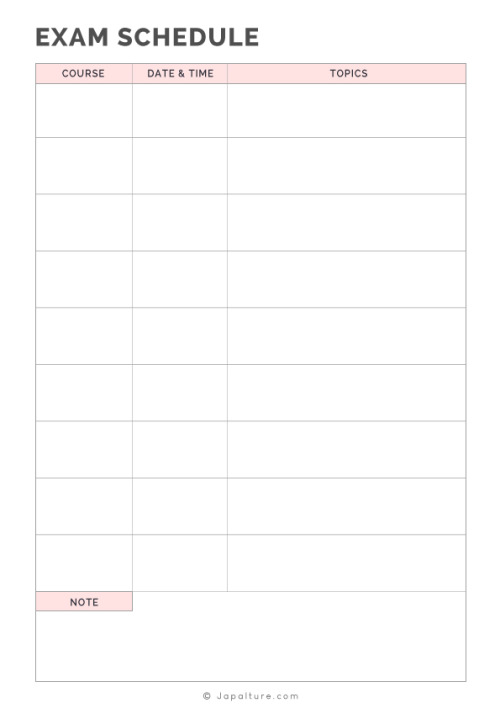
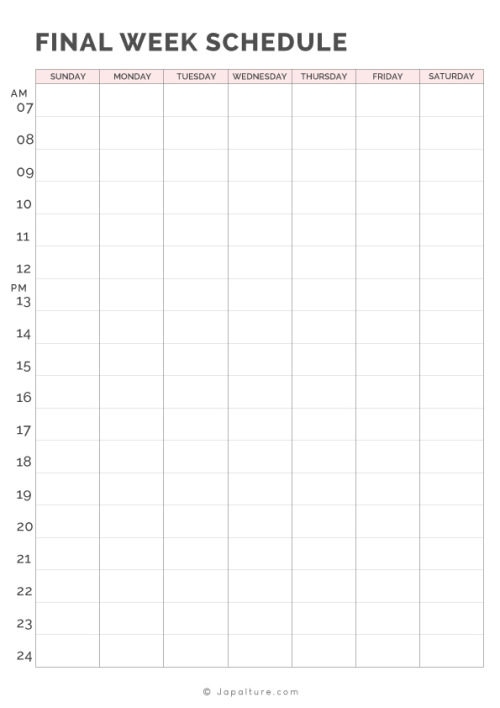
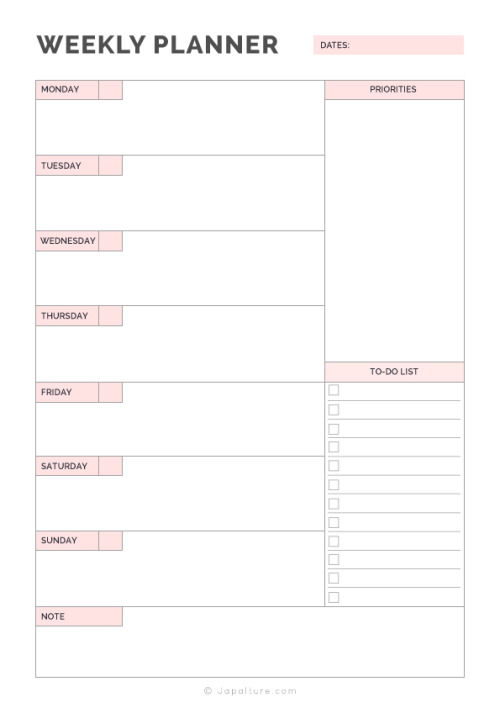
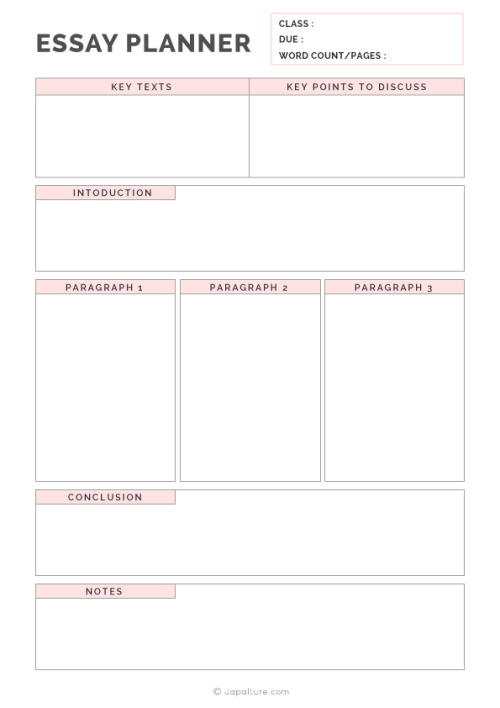
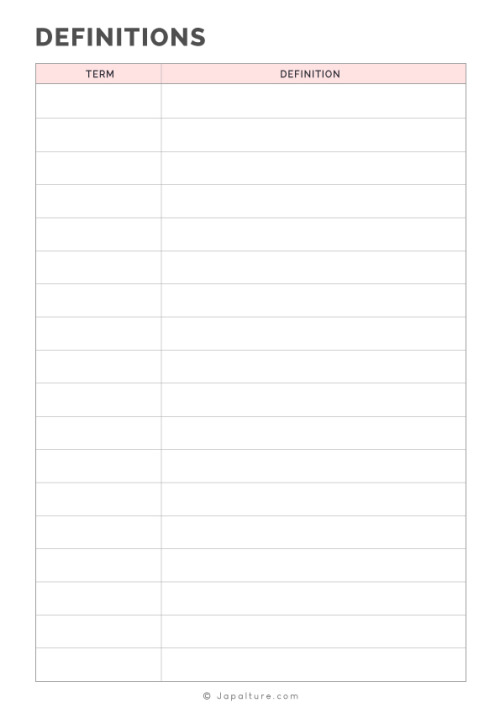

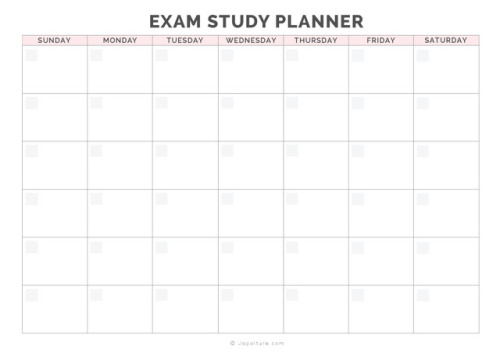
Hi, there! I have a big exam next month and decided to create an exam study kit to organize and increase my productivity. I hope this exam study pack help your final exam. Good luck with your exam, everyone! We can do it!
Exam Study Pack Including
Final Exam Schedule
Final Exam Time Schedule (week)
Weekly Study planner
Monthly Style Study planner
Essay Planner
Glossary (definitions & terms)
Note
Click HERE to download the printable (PDF). Please save the file to your computer and open with Adobe Reader DC. Use Adobe Reader, otherwise, it will not work correctly and colors may display completely different. Please let me know if you are having trouble downloading the file.
* Important note: All files are Personal Use (non-commercial) ONLY! Please Do NOT Copy and Edit. Please Do No distribute and sell these files or upload them to other websites.
By the way, I decided to post a new printable item each week (every Saturday). Tomorrow I will post “Free Printable Thanksgiving 2018 Wine Labels” including using a Japanese pattern. So please come back to my blog tomorrow!
Japanese listening practice for beginners - Youtube videos
“キッズボンボン for Children” channel
All of the videos on this list have Japanese subtitles. It is mostly in ひらがな and the words are separated. This and the fact that these videos are aimed for children, makes them great for beginners.
PEACH BOY - MOMOTARO (JAPANESE) Japanese classical stories | fairy tale
KINTARO (Japanese) Japanese classical stories | fairy tale
USHIWAKAMARU (JAPANESE) Japanese classical stories | fairy tale
SHINING PRINCESS (JAPANESE) Japanese classical stories | fairy tale
THE TONGUELESS SPARROW (JAPANESE) Japanese classical stories | fairy tale
THE DANCING KETTLE (JAPANESE) Japanese classical stories | fairy tale
THE STORY OF THE MONKEY AND THE CRAB (JAPANESE) Japanese classical stories | fairy tale
CLACK CLACK MOUNTAIN (JAPANESE) Japanese classical stories | fairy tale
OLD MAN WITH THE LUMP (JAPANESE) Japanese classical stories | fairy tale
OLD MAN FLOWER (JAPANESE) Japanese classical stories | fairy tale
THE YOUNG MONK IKKYU (JAPANESE) Japanese classical stories | fairy tale
THE GRATEFUL CRANE (JAPANESE) Japanese classical stories | fairy tale
URASHIMA TARO (JAPANESE) / うらしまたろう - 浦島太郎(日本語版)Japanese classical stories | fairy tale
THE SNOW WOMAN (JAPANESE) Japanese classical stories | fairy tale
THE ROLLING RICE BALL (JAPANESE) Japanese classical stories | fairy
INCH BOY (JAPANESE) Japanese classical stories | fairy tale
THE CHILD GODS (JAPANESE) Japanese classical stories | fairy tale
THE STORY OF THE ZODIAC (JAPANESE) Japanese classical stories | fairy tale
All of these videos have an English version on this channel. Search for them or click on this playlist. You can use both versions to study what’s being said.
SNOW WHITE (JAPANESE) fairytale | Folktales | bedtime stories
THUMBLINA (JAPANESE) | Folktales | bedtime stories
JACK AND THE BEANSTALK (JAPANESE) | Folktales | bedtime stories
PETER PAN (JAPANESE) | Folktales | bedtime stories
A DOG OF FLANDERS (JAPANESE) | Folktales | bedtime stories
PINOCCHIO (JAPANESE) | Folktales | bedtime stories
PUSS IN BOOTS (JAPANESE) | Folktales | bedtime stories
ALADDIN AND THE MAGIC LAMP (JAPANESE) | Folktales | bedtime stories
THE WOLF AND THE SEVEN LITTLE GOATS (JAPANESE) | Folktales | bedtime stories
CINDERELLA (JAPANESE) | Folktales | bedtime stories
THE LITTLE MATCH SELLER | Folktales | bedtime stories
HE MERMAID PRINCESS | Folktales | bedtime stories
LITTLE RED RIDING HOOD | Folktales | bedtime stories
THE THREE LITTLE PIGS (JAPANESE) | Folktales | bedtime stories
THE ADVENTURE OF TOM SAWYER (JAPANESE) | Folktales | bedtime
THE WIZARD OF OZ (JAPANESE) | Folktales | bedtime stories
THE UGLY DUCKLING (JAPANESE) | Folktales | bedtime stories
ALICE IN WONDERLAND (JAPANESE) | Folktales | bedtime stories
All of these videos have an English version on this channel. Search for them or click on this playlist. You can use both versions to study what’s being said.







